| [1] 汪丽静,崔艳玲,孙丽敏,等.复方丹参注射液对脑梗死患者血管内皮细胞功能的影响[J].中国当代医药,2011,18(7):74-75.[2] 王新杰.复方丹参注射液联合纳洛酮治疗新生儿缺氧缺血性脑病[J].中国实验方剂学杂志,2013,19(12):338-340.[3] 刘志刚,孙宜芬,孟红旗.丹参注射液液治疗急性脑梗死90例临床观察[J].中国民族民间医药杂志,2015,24(22):78-79.[4] Yoshida Y, Yamanaka S. Recent stem cell advances: induced pluripotent stem cells for disease modeling and stem cell-based regeneration. Circulation. 2010;122(1):80-87.[5] 沙德潜,陈伟.盐酸法舒地尔在脂肪干细胞向表皮细胞诱导分化中的作用[J].新乡医学院学报,2011,28(6):711-713.[6] Gage FH, Temple S. Neural stem cells: generating and regenerating the brain. Neuron. 2013;80(3):588-601.[7] 刘波,朱金土,曹毅,等.脂肪干细胞定向诱导分化为成骨细胞及其鉴定[J].中华中医药学刊,2011,29(12):2680-2681,2843.[8] Kim SU. Neural stem cell-based gene therapy for brain tumors. Stem Cell Rev. 2011;7(1):130-140.[9] 周向阳,邓永文,方芳,等.大鼠脂肪干细胞的培养及向神经细胞的定向分化[J].中国现代医学杂志, 2010, 20(4):530-534.[10] Maciaczyk J, Singec I, Maciaczyk D, et al. Restricted spontaneous in vitro differentiation and region-specific migration of long-term expanded fetal human neural precursor cells after transplantation into the adult rat brain. Stem Cells Dev. 2009;18(7):1043-1058.[11] Zhang ZH, Wang RZ, Wang RZ, et al. Transplantation of neural stem cells modified by human neurotrophin-3 promotes functional recovery after transient focal cerebral ischemia in rats. Neurosci Lett. 2008;444(3):227-230.[12] Andres RH, Horie N, Slikker W, et al. Human neural stem cells enhance structural plasticity and axonal transport in the ischaemic brain. Brain. 2011;134(Pt 6):1777-1789. [13] Roelofs HM, Te Morsche RH, van Heumen BW, et al. Over-expression of COX-2 mRNA in colorectal cancer. BMC Gastroenterol. 2014;14:1.[14] Lin JY, Wang WA, Zhang X, et al. Intraneuronal accumulation of Aβ42 induces age-dependent slowing of neuronal transmission in Drosophila. Neurosci Bull. 2014;30(2): 185-190.[15] 林福虹,郑荣远,王沛,等. 2-BFI对EAE小鼠iNOS和COX-2 mRNA表达的影响[J].中国神经免疫学和神经病学杂志, 2011, 18(1):27-31.[16] 邵瑛,王艳芳,冯德琳,等.电针对血管性痴呆大鼠在体海马CA1 区β淀粉样蛋白1-40的影响[J].广州中医药大学学报,2014,31(3): 389-393.[17] 李振华,承欧梅,蒋青松,等.黄芩苷抑制beta淀粉样蛋白诱导的海马COX-2蛋白表达[J].中国中西医结合杂志,2011,31(5): 676-679. [18] 李宁,宋莲军,张平安,等.铅暴露对仔鼠海马中β淀粉样蛋白40表达影响[J].中国公共卫生,2012,28(9):1205-1206.[19] 吴磊,赵建华,冯继.不同环氧合酶-2抑制剂治疗大鼠脑外伤早期炎症实验观察[J].陕西医学杂志,2012,41(5):525-527.[20] Paradis V, Perlemuter G, Bonvoust F, et al. High glucose and hyperinsulinemia stimulate connective tissue growth factor expression: a potential mechanism involved in progression to fibrosis in nonalcoholic steatohepatitis. Hepatology. 2001;34(4 Pt 1):738-744.[21] Mura E, Zappettini S, Preda S, et al. Dual effect of beta-amyloid on α7 and α4β2 nicotinic receptors controlling the release of glutamate, aspartate and GABA in rat hippocampus. PLoS One. 2012;7(1):e29661.[22] Reed-Geaghan EG, Savage JC, Hise AG, et al. CD14 and toll-like receptors 2 and 4 are required for fibrillar A{beta}-stimulated microglial activation. J Neurosci. 2009; 29(38):11982-11992.[23] Du H, Yan SS. Mitochondrial permeability transition pore in Alzheimer's disease: cyclophilin D and amyloid beta. Biochim Biophys Acta. 2010;1802(1):198-204.[24] Arispe N, Diaz J, Durell SR, et al. Polyhistidine peptide inhibitor of the Abeta calcium channel potently blocks the Abeta-induced calcium response in cells. Theoretical modeling suggests a cooperative binding process. Biochemistry. 2010;49(36):7847-7853. |
.jpg)


.jpg)